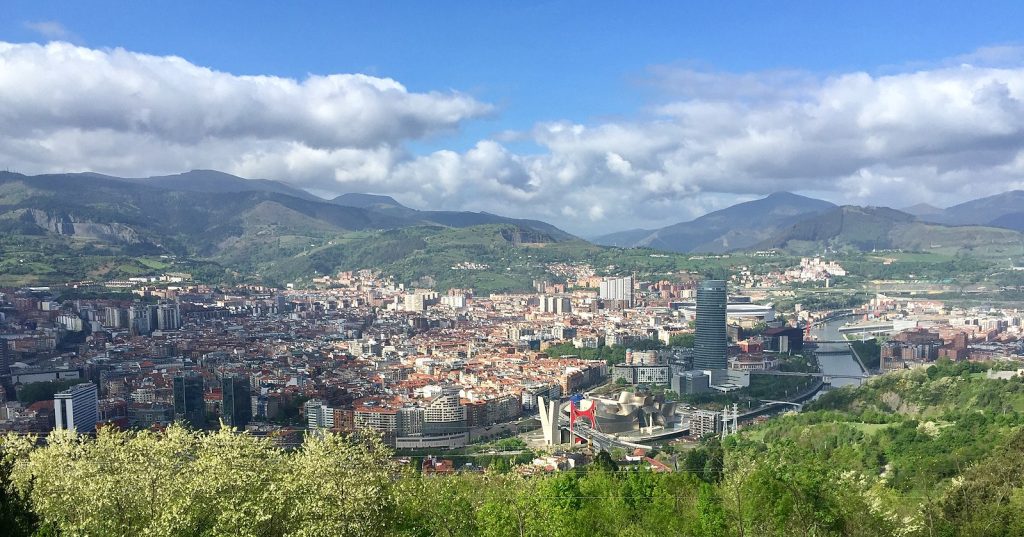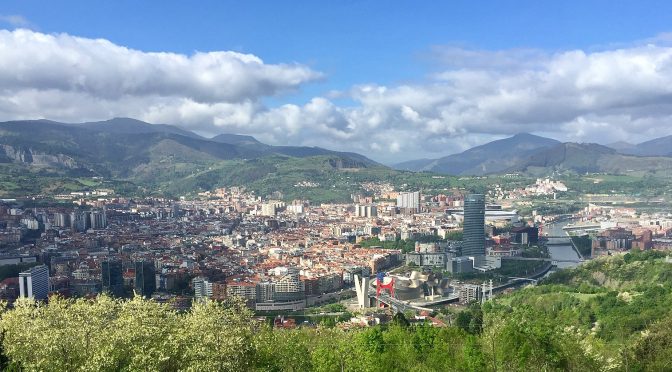Though my dad grew up in Bizkaia, because I lived in Donostia when I spent my year abroad in the Basque Country, I never really got to know the capital of his home province. Bilbo always seemed a bit foreboding, a bit too big for me to grasp during a day excursion. Of course, I’ve wandered the Casco Viejo and took in the Guggenheim. (I took my dad’s sisters there once. When we left, I asked what they thought and they shrugged. “The frames were nice.”) My friend Aitor even took us to see the “cathedral” – San Mamés, where Athletic Bilbao plays – though I still haven’t seen them play myself. However, I’ve never really gotten to know the city, despite its central importance to Basque history and economy.

- Bilbo is the Basque spelling of the more familiar Bilbao. In the letter of its founding, back in 1300, the city is referred to as Biluao. Bilbo as the spelling dates back to at least 1794. Though the origins of the name are debated, with multiple theories, one possibility is that it comes from the words bilbe ‘weave’ and aho ‘boca,’ meaning something like the ‘the mouth, the entrance of the weave,’ referring to how the streams of the original site weaved together. Around 1600, Shakespeare used the word ‘bilbo‘ to refer to a sword – inspired by Bizkaian iron – in one of his plays, suggesting that it was a common word at the time.
- By the 12th century, a center of population had grown up around what is today Bilbo, built around the monasteries, such as Begoña. The city proper was founded in 1300 by Diego López V de Haro, though there is some evidence suggesting a previous, but failed, founding of a city in the same location. In 1310, López de Haro’s niece, María Díaz I de Haro, refounded the city, strengthening its commercial position by making it a required stop for traffic from Castile. In 1602, Bilbo was made the capital of Bizkaia, a position previously held by Bermeo.
- The city became the economic heart of the Basque Country in the 18th and 19th centuries, a time that saw the railroad arrive in the city, the Bank of Bilbao founded, and the Bilbao Stock Exchange begin. Steelmaking was one of the key industries of the city. In just the 20 years from 1880 to 1900, the city’s population grew from 11,000 to 80,000.
- The city also saw a great deal of conflict. It was besieged during the First and Third Carlist Wars, as well as the Spanish Civil War. It was also bombed during the Spanish Civil War, with at least 100 bombs dropped on September 25, 1936. After the Civil War, a huge amount of immigration from other parts of Spain fed the developing economy, often leading to poor conditions for workers and the development of social movements in response.
- Beginning in 1861, Bilbo began annexing nearby neighborhoods, beginning with Abando and Begoña. It continued to grow, absorbing more nearby localities: Deustu, Uribarri, Otxarkoaga-Txurdinaga, Casco Viejo, Rekalde, and Basurtu-Zorrotza. These now form various districts within Bilbo.
- Bilbo was built on mining, steel manufacturing, and shipbuilding. However, by the mid 1980s, the so-called “Great Crisis” took its toll, with Bizkaia and Gipuzkoa having the highest unemployment in all of Europe. Some of the historic companies of greater Bilbo closed their doors. Further, Bilbo was simply dirty, a consequence of all of that industry. However, governments across various levels undertook a revitalization plan, which included the restructuring of the port, the construction of the Metro, and the demolition of industrial ruins.
- This revitalization is perhaps no better symbolized than by the Guggenheim Museum, which opened in 1997 on the grounds of the old port. Designed by Frank Gehry, it was first criticized as the “McDonaldization” of culture. However, even some of its most ardent critics have come to recognize the revitalizing force that the museum and the related efforts brought to the city.
Primary sources: Serrano Abad, Susana. Bilbao. Historia. Auñamendi Encyclopedia. Available at: https://aunamendi.eusko-ikaskuntza.eus/en/bilbao-historia/ar-7060/; Auñamendi Entziklopedia. Bilbao. Auñamendi Encyclopedia. Available at: https://aunamendi.eusko-ikaskuntza.eus/en/bilbao/ar-14110/; Bilbao, Wikipedia
Discover more from Buber's Basque Page
Subscribe to get the latest posts sent to your email.



It’s not quite right about Shakespeare using Bilbo to mean a sword. In Hamlet, Act 5, scene ii, line 6 he writes: “the mutinies in the bilboes”, meaning shackles. fetters were made in Bilbao.
Thanks Andrew! I’d read multiple times that it meant sword and sword is one definition of bilbo, but I hadn’t realized there was another! Thanks for pointing this out! https://www.thefreedictionary.com/bilbo